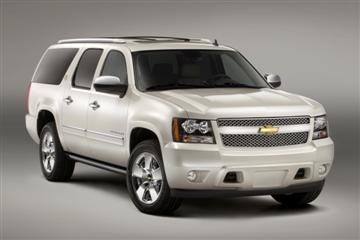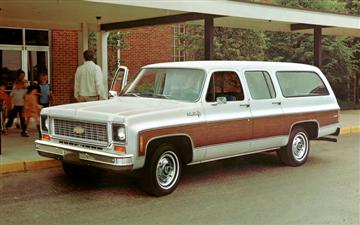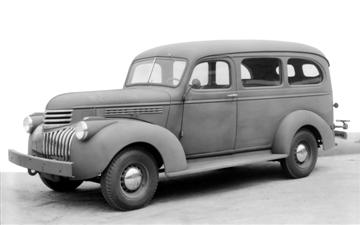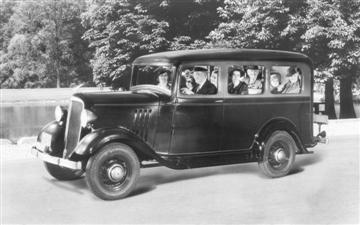Chevrolet Suburban: 75 years on
|
|
|
 2010 Chevrolet Suburban 75th Anniversary Diamond Edition
2010 Chevrolet Suburban 75th Anniversary Diamond Edition
 1973 Chevrolet Suburban
1973 Chevrolet Suburban
 1941 Chevrolet Suburban
1941 Chevrolet Suburban
 1935 Chevrolet Suburban
1935 Chevrolet Suburban
|
|
|
Home >
News >
GM >
Chevrolet
23rd February, 2010
In 1935, the United States’ population was a little more than
127 million. A first-class stamp cost 3 cents, Technicolor was introduced to motion pictures. It was also the
year Chevrolet introduced the Suburban.
In the seven and a half decades since its introduction, the Chevrolet Suburban became an American icon and
the industry’s longest-running model. In fact, Suburban is the first vehicle to reach 75 years of production
and Chevrolet is commemorating the milestone with a new 2010 Suburban 75th Anniversary Diamond Edition
model.
“Times have changed, but the Suburban remains a fixture in the industry for private and professional
customers who need truck-like towing capability with maximum passenger and cargo space,” said Jim Campbell,
Chevrolet general manager. “The Suburban’s core capabilities and dependability have remained constant for
more than seven decades and generations of people know that a Suburban will haul people and their
gear.”
The original Suburban could seat eight, while easily removable seats provided a large, 75 inch-long by 77
inch-high (1,905 x 1,956 mm) cargo area. The 2010 Suburban seats up to nine, but offers up to 137.4 cubic feet
(3,891 L) of cargo space when the second-row seats are folded and third-row seats are removed.
History of the Suburban
The idea for the Suburban was born out of a need for a heavier-duty, truck-based wagon. Through the early
1930s, most manufacturers offered car-based wagons for professional use. Open models with windows and rear
seating were known as depot hacks, and were used to ferry passengers and their cargo around train stations
and boat docks. Enclosed models, typically without rear seats, were known as sedan deliveries.
Bodywork for these early vehicles often consisted of wood sides and canvas tops; and while they were
versatile, their car-based chassis and damage-prone bodies were compromises. Chevrolet began experimenting with
an all-steel wagon body mounted on a commercial chassis in the mid-1930s, and the Suburban Carryall was
launched in 1935.
Car-based commercial vehicles, including sedan deliveries, remained in production, but the heavy-duty
chassis of the Suburban increasingly found favour with professional customers. In the post-World War II years,
its popularity with private customers who appreciated its uncompromising capabilities increased steadily.
The Chevrolet Suburban hit the mainstream in the early 1990s, with the overall popularity of sport-utility
vehicles. But while many customers were new to the Suburban then, it had garnered a legion of longtime owners
who had purchased multiple examples over the years – using them to haul equipment, tow a horse trailer or seat
a work crew on the way to a job site.
Here’s a timeline of significant moments in the Suburban’s first 75 years:
1935: Suburban Carryall introduced with a signature two-door body style that would last through 1967. Power
came from Chevrolet’s stalwart “Stovebolt” in-line six that produced 60 horsepower (45 kW) for the half-ton
chassis.
1937: New, streamlined exterior styling carried Art Deco cues, and horsepower from the Stovebolt six
increased to 79 (59 kW).
1942: Production of almost all civilian cars and trucks halted during America’s involvement in World War II,
although many Chevy trucks – including the Suburban’s body style – were pressed into military duty.
1947: The first significant redesign of the Chevrolet’s truck line – including Suburban – since before the
war. Torque from the in-line six engine was 174 lb.-ft. (217 Nm) at only 1,200 rpm, giving the Suburban
excellent towing capability.
1950: Suburban models are offered with either a tailgate/top-opening rear window configuration or
conventional “barn doors” at the rear.
1955: Revolutionary new styling is introduced mid-way through the model year. Known as the “second series”
design, it features a wraparound windshield and the elimination of running boards – the body is flush with
the guards for the first time. The second series model also introduces the ubiquitous small-block V-8.
1957: Factory-installed four-wheel drive is offered for the first time, with the famous NAPCO-supplied
“Powr-Pak” system.
1960: Chevrolet institutes the C/K designations to denote models with 2WD (C) and 4WD (K). Front-end
styling is also new.
1967: All-new styling of Chevy’s half-ton trucks is introduced, including Suburban. It carries a unique
three-door arrangement with a single door on the driver’s side and front and rear doors on the passenger
side. This configuration makes the Suburban popular with ambulance companies.
1973: A new generation of Chevy trucks is launched, with Suburban offered in a conventional four-door
body style introduced for the first time. Its 129.5-inch (3,289 mm) wheelbase was only 0.5-inch (12.7 mm)
shorter than the 2010 model’s. Also debuting is the Suburban three-quarter-ton model, which could be had
with a 454 big-block engine that delivered 335 lb.-ft. of torque (455 Nm).
|
|
|

Self-Catering Holiday
Accommodation in
Denmark, WA
..... more
|
|
|
1975: Increased focus on interior comfort and amenities in the 1973 models bring more customers to
Suburban for use as a personal vehicle. Chevrolet responds with more comfortable seats and greater
amenities, including simulated buffalo hide vinyl upholstery, wood grain dash inserts, fully trimmed door
panels and more.
1981: Updated styling brings stacked rectangular headlamps for the 1980s. The 4WD system adds automatic
locking hubs and the 454 big-block is still offered, giving customers great towing capability.
1987: Electronically controlled fuel injection and a four-speed overdrive transmission bring greater
efficiency.
1992: An all-new Suburban features sleek styling with flush glass and composite headlamps. The 5.7L
small-block V-8 powers 1500 models, while the 454 (7.4L) engine is still available in the 2500 series.
Other updates include four-wheel anti-lock brakes, Insta-Trac on four-wheel-drive models and a suspension
system designed to provide a more car-like ride.
1998: OnStar and the full-time AutoTrac all-wheel-drive system are added. In Australia, right-hand-drive
versions of the Suburban are offered, unsuccessfully, through GM’s Holden brand.
2000: Launched in 1999 as a 2000 model, the next-generation Suburban brings new styling, new interiors
and new powertrains. The engines include the Vortec 5.3L and 6.0L V-8s that were from the same Gen III V-8
“LS” family that debuted a couple of years earlier as the LS1 in the Corvette. Other new features include
four-wheel disc brakes and a load-leveling suspension system.
2007: The latest generation of the Suburban is introduced, featuring a wind tunnel-shaped exterior and
the elimination of traditional chrome front and rear bumpers. More efficient, comfortable and capable than
ever, the Suburban continues to offer customers of all walks of life uncompromising capability and
versatility.
2010: The 75th anniversary is marked with a limited-edition model, the 75th Anniversary Diamond Edition
Suburban, which was launched at the Chicago Motor Show.
|